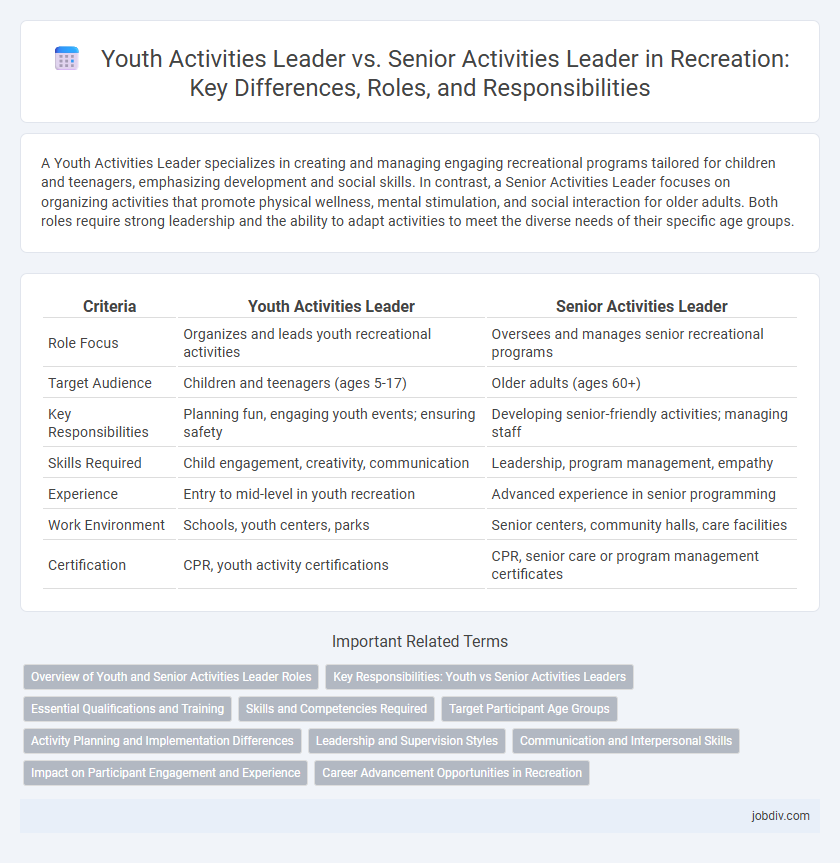A Youth Activities Leader specializes in creating and managing engaging recreational programs tailored for children and teenagers, emphasizing development and social skills. In contrast, a Senior Activities Leader focuses on organizing activities that promote physical wellness, mental stimulation, and social interaction for older adults. Both roles require strong leadership and the ability to adapt activities to meet the diverse needs of their specific age groups.
Table of Comparison
| Criteria | Youth Activities Leader | Senior Activities Leader |
|---|---|---|
| Role Focus | Organizes and leads youth recreational activities | Oversees and manages senior recreational programs |
| Target Audience | Children and teenagers (ages 5-17) | Older adults (ages 60+) |
| Key Responsibilities | Planning fun, engaging youth events; ensuring safety | Developing senior-friendly activities; managing staff |
| Skills Required | Child engagement, creativity, communication | Leadership, program management, empathy |
| Experience | Entry to mid-level in youth recreation | Advanced experience in senior programming |
| Work Environment | Schools, youth centers, parks | Senior centers, community halls, care facilities |
| Certification | CPR, youth activity certifications | CPR, senior care or program management certificates |
Overview of Youth and Senior Activities Leader Roles
Youth Activities Leaders design and implement engaging programs tailored to children and adolescents, focusing on skill development, social interaction, and recreation within schools or community centers. Senior Activities Leaders oversee complex activities for adults and seniors, emphasizing physical wellness, cognitive stimulation, and social inclusion while managing program staff and resources. Both roles require leadership, creativity, and communication skills to foster positive group dynamics and ensure participant safety.
Key Responsibilities: Youth vs Senior Activities Leaders
Youth Activities Leaders coordinate age-appropriate recreational programs, focusing on developing social skills, teamwork, and creativity among children and adolescents. Senior Activities Leaders manage and design comprehensive activity schedules for diverse age groups, oversee staff training, and ensure compliance with safety regulations. Both roles require strong organizational and leadership skills, but Senior Leaders carry increased responsibility for program quality and operational oversight.
Essential Qualifications and Training
Youth Activities Leaders require foundational qualifications such as CPR certification, basic first aid, and experience in youth engagement programs, emphasizing strong communication and leadership skills. Senior Activities Leaders demand advanced certifications, including specialized training in risk management, program development, and team supervision, alongside extensive experience coordinating diverse recreational activities. Training for Senior Leaders often involves leadership workshops and conflict resolution techniques to manage larger groups and mentor junior staff effectively.
Skills and Competencies Required
A Youth Activities Leader requires strong communication skills, creativity in program development, and the ability to engage diverse age groups effectively. A Senior Activities Leader demands advanced leadership abilities, strategic planning skills, and proficiency in mentoring junior staff to ensure smooth operation and enhanced participant experiences. Both roles necessitate excellent organizational skills, but the senior position places greater emphasis on supervisory responsibilities and program evaluation.
Target Participant Age Groups
Youth Activities Leaders primarily engage with children and adolescents aged 6 to 17, designing age-appropriate programs that foster development and social interaction. Senior Activities Leaders focus on older adults, typically 60 and above, creating recreational and social activities that promote physical health, mental well-being, and community engagement. Tailoring activities to specific age-related needs ensures that both age groups receive supportive and enriching experiences.
Activity Planning and Implementation Differences
Youth Activities Leaders primarily focus on developing and executing age-specific programs that encourage engagement, creativity, and skill development for children and adolescents. Senior Activities Leaders manage more complex scheduling, coordinate multiple youth programs simultaneously, and oversee compliance with safety regulations and organizational goals. The Senior role requires strategic planning skills to allocate resources efficiently while ensuring a diverse range of activities that meet community needs.
Leadership and Supervision Styles
Youth Activities Leaders prioritize hands-on engagement and peer interaction to foster creativity and teamwork among young participants, employing an energetic and approachable leadership style. Senior Activities Leaders adopt a strategic supervision approach, emphasizing program development, risk management, and staff mentoring to ensure smooth operation of activities and overall participant safety. Effective leadership in recreation balances direct involvement with oversight to maximize youth engagement and program quality.
Communication and Interpersonal Skills
Youth Activities Leaders excel in fostering open communication and building rapport with younger participants through active listening and empathy, which enhances engagement and trust. Senior Activities Leaders demonstrate advanced interpersonal skills by managing diverse groups, resolving conflicts efficiently, and facilitating collaborative teamwork among both youth and staff. Strong communication abilities in both roles are essential for creating inclusive, motivating environments that promote positive social interaction and personal development.
Impact on Participant Engagement and Experience
Youth Activities Leaders directly foster participant engagement by creating age-appropriate programs that encourage active involvement and social interaction among young participants. Senior Activities Leaders enhance the overall experience by overseeing program development, ensuring inclusivity, and providing mentorship to Youth Leaders, resulting in more cohesive and impactful recreational activities. The combined leadership approach significantly improves participant satisfaction and long-term commitment to recreational programs.
Career Advancement Opportunities in Recreation
Youth Activities Leaders gain foundational experience coordinating programs for children and teens, developing skills essential for higher responsibility roles in recreation management. Senior Activities Leaders oversee broader recreational programs, mentor junior staff, and contribute to strategic planning, presenting clear pathways for career advancement. Progression from youth to senior leadership positions enhances expertise in program development, staff supervision, and community engagement within the recreation sector.
Youth Activities Leader vs Senior Activities Leader Infographic

 jobdiv.com
jobdiv.com